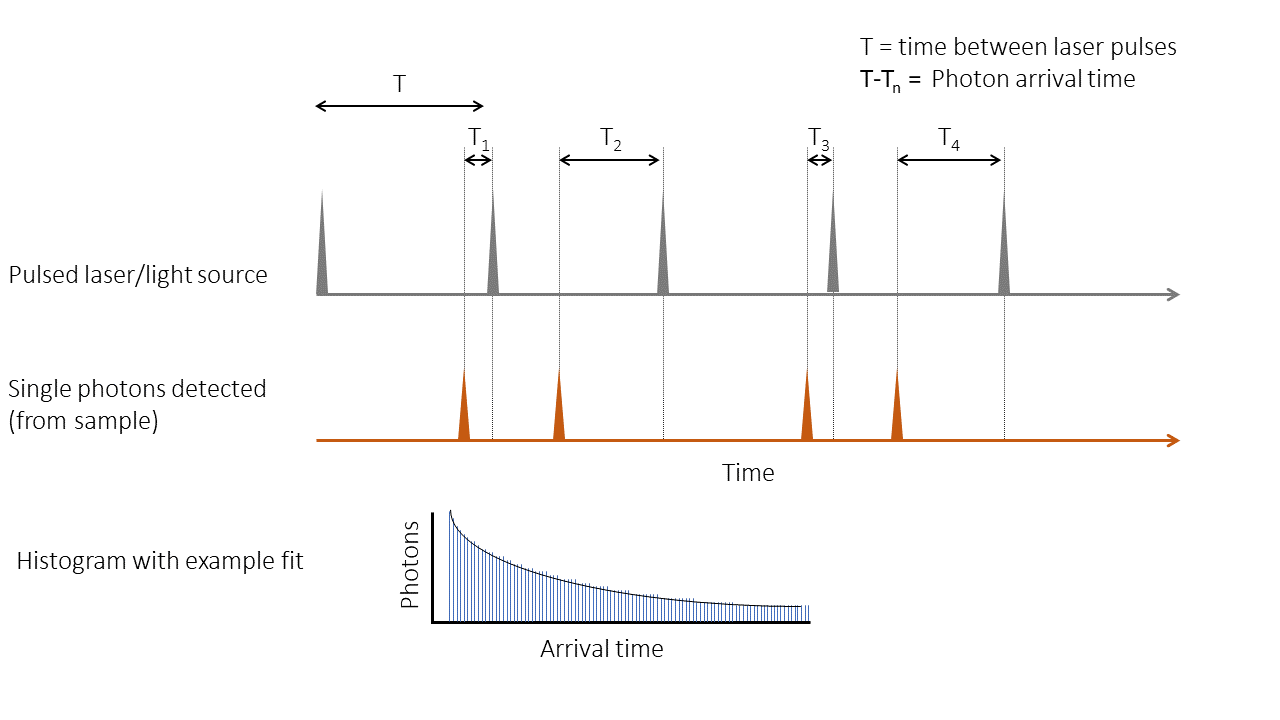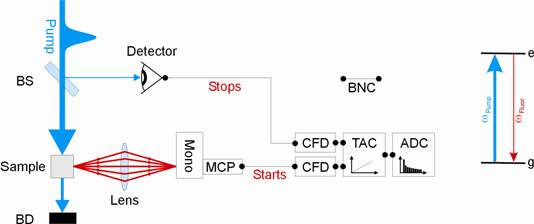Time Correlated Single Photon Counting
Time Correlated Single Photon Counting in bulk solutions has and continues to be a workhorse of our long term research into synthetic electron- and charge-transfer systems. The continued development of these systems will lead to the next generation of cheap and durable plastics based optical materials for a myriad applications including display technology, optical switching and energy storage for computing, solar cells and protection from photodegradation, to name a few.
Time-correlated single-photon counting (TCSPC) is a convenient statistical method for recording time-resolved fluorescence data, providing kinetic information on excited state photochemical reactions. This technique utilises a high-repetition-rate pulsed laser which repeatedly excites the sample, typically at MHz excitation rates. Sample fluorescence is collected, passed through a monochromator, and detected with a single-photon counting detector. Detection of single photons is achieved with a high-gain photodetector such as a multi-channel plate, avalanche photodiode or other photomultiplier. In order to ensure that a maximum of one photon is measured per excitation cycle, the count rate of the sample is kept to below 5% of the frequency of the excitation source.
The time of arrival of this photon relative to the laser pulse is recorded and put into an appropriate time bin. As the measurement runs, the bins associated with different arrival times build up with photon counts giving a histogram which is the fluorescence decay profile.
This technique is usually run in reverse timing mode, where the arrival of the photon from the sample starts the timer and the following laser pulse trigger signal stops the timer. This way less time is wasted waiting for the arrival of a photon which is less frequent than the regular laser pulse signal.
The time resolution of the experiment is determined by the type of detector used and the jitter of the electronics, typically < 100 ps. The time range over which measurements are made can be tuned by changing the repetition-rate of the light source, allowing measurements over an adjustable time window from picoseconds to milliseconds.
TCSPC can be combined with a confocal microscope to obtain time-domain fluorescence measurements in an image context. By rastoring the excitation source over the sample it is possible to record a fluorescence decay profile in each pixel of the image.
Figure 1. Experimental apparatus for TCSPC measurements in bulk solutions for determining fluorescence lifetimes on a ns timescale. BS = beam splitter, BD = beam dump, Mono = monochrometer, MCP = Multi Channel Plate, CFD = constant fraction discriminator, TAC = time to amplitude converter, ADC = analogue to digital converter. Figure 2. Demonstration of the reverse mode of the TCSPC technique. The arrival of a photon at the detector starts the timing process which is stopped at the next laser pulse. The difference between the time between laser pulses and the start time (photon arrival time) gives the true arrival time of the photon.
Figure 2. Demonstration of the reverse mode of the TCSPC technique. The arrival of a photon at the detector starts the timing process which is stopped at the next laser pulse. The difference between the time between laser pulses and the start time (photon arrival time) gives the true arrival time of the photon.
Sources:
O’Connor, D.V.O., Phillips, D., “Time-correlated Single Photon Counting”, Academic Press, London, 1984
Becker, W. “Advanced Time-Correlated Single Photon Counting Techniques”, Springer-Verlag, 2005 doi:10.1007/3-540-28882-1.
Edinburgh Instruments, “What is Time-Correlated Single Photon Counting?” Blog entry, Edinst.com, 2018.

